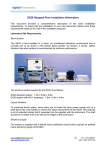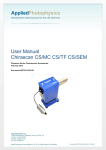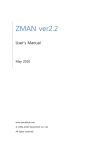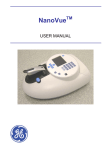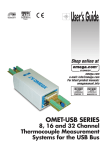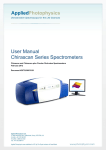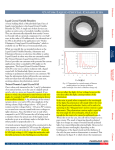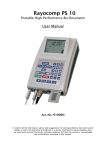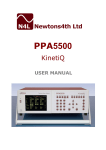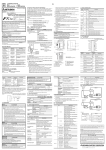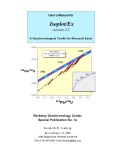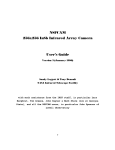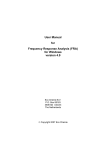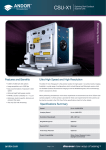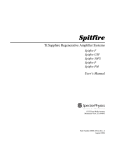Download User Manual Chirascan CS/ORD
Transcript
CS/ORD Accessory User Manual User Manual Chirascan CS/ORD Chirascan Series Optical Rotatory Dispersion Accessory February 2012 Document 4207Q112C03.01 Document 4207Q112C03.01 Page 1 of 15 CS/ORD Accessory User Manual This page is intentionally left blank Document 4207Q112C03.01 Page 2 of 15 CS/ORD Accessory User Manual This document contains important safety information. Read this document and the Chirascan series User Manual before attempting to install or use the CS/ORD accessory. Failure to do so could result in death or serious injury. Document 4207Q112C03.01 Page 3 of 15 CS/ORD Accessory User Manual USE OF THIS DOCUMENT This document is intended to inform the operator of Applied Photophysics’ CS/ORD optical rotatory dispersion accessory on its design, installation and operation with either the Chirascan or Chirascan-plus spectrometer. It is assumed that the user of this document is familiar with the operation of the Chirascan or Chirascan-plus, and with Applied Photophysics Pro-Data software. In particular it is assumed that the user is familiar with the hazards associated with the operation of the spectrometer, and has read the safety information contained in its User Manual. Note that the CS/ORD is normally used with the CS/PCS single cell temperature control accessory, and the some of the images of the interior of the spectrometer Sample Handling Unit show this unit in place. The information in this document is subject to change without notice and should not be construed as a commitment by Applied Photophysics, who accept no responsibility for errors that may appear herein. This document is believed to be complete and accurate at the time of publication, and in no event shall Applied Photophysics be held responsible for incidental or consequential damages with or arising from the use of this document. COPYRIGHT 2012 APPLIED PHOTOPHYSICS LTD. ALL RIGHTS RESERVED. THIS DOCUMENT OR PARTS THEREOF SHALL NOT BE REPRODUCED IN ANY FORM WITHOUT THE WRITTEN PERMISSION OF THE PUBLISHER. THE SOFTWARE PROVIDED WITH THE CHIRASCAN AND ITS ACCESSORIES (PRO-DATA CHIRASCAN, PRO-DATA VIEWER, ETC.) IS THE PROPERTY OF APPLIED PHOTOPHYSICS LTD. (“APL”) AND IS SUPPLIED UNDER LICENCE. APL IS WILLING TO LICENSE THE SOFTWARE ONLY UPON THE CONDITION THAT THE LICENSEE ACCEPTS ALL THE TERMS CONTAINED IN THE LICENCE AGREEMENT. THESE INCLUDE THAT THE LICENSEE MAY NOT SELL, RENT, LOAN OR OTHERWISE ENCUMBER OR TRANSFER LICENSED SOFTWARE IN WHOLE OR IN PART TO ANY THIRD PARTY. FOR A FULL COPY OF THE LICENCE PLEASE CONTACT APL OR SEE THE SOFTWARE INSTALLATION DISC. Chirascan™ and Chirascan™-plus are trademarks of Applied Photophysics Ltd. Microsoft® and Windows® are registered trademarks of Microsoft Corporation in the United States and other countries. Sigma-Aldrich® is a registered trademark of Sigma Aldrich Co., Missouri, United States. All other trademarks or registered trademarks are the sole property of their respective owners. Document 4207Q112C03.01 Page 4 of 15 CS/ORD Accessory User Manual HAZARD AND OTHER INDICATORS HAZARD INDICATORS USED IN THIS DOCUMENT The sign to the left is used to indicate a hazardous situation, which, if not avoided, could result in death or serious injury. Document 4207Q112C03.01 Page 5 of 15 CS/ORD Accessory User Manual ESSENTIAL SAFETY INFORMATION MAKE SURE THAT YOU HAVE READ AND UNDERSTAND ALL THE SAFETY INFORMATION CONTAINED IN THIS DOCUMENT BEFORE ATTEMPTING TO INSTALL OR OPERATE THE OPTICAL ROTATORY DISPERSION ACCESSORY. IF YOU HAVE ANY QUESTIONS REGARDING THE OPERATION OF THE ACCESSORY, PLEASE CONTACT APL TECHNICAL SUPPORT SECTION AT THE ADDRESS SHOWN ON THE FIRST PAGE OF THIS DOCUMENT. OBSERVE ALL SAFETY LABELS AND NEVER ERASE OR REMOVE SAFETY LABELS. PERFORMANCE OF INSTALLATION, OPERATION OR MAINTENANCE PROCEDURES OTHER THAN THOSE DESCRIBED IN THIS USER MANUAL MAY RESULT IN A HAZARDOUS SITUATION AND WILL VOID THE MANUFACTURERS WARRANTY. The CS/ORD detector operates at high voltages and can produce a shock leading to serious injury or death. Do not connect or disconnect the detector from the spectrometer unless the spectrometer is powered off. The spectrometer is powered by the mains electricity supply which can produce a shock leading to serious injury or death. Do not connect or disconnect the instrument from the mains supply unless the supply is powered off at source. Ensure all communications and electrical connections are made before powering on the spectrometer. Exercise care during operation and do not operate units with their covers removed. Operate the spectrometer using only the cables provided. Never operate a spectrometer with damaged cables. The spectrometer may be equipped with a light source (150 watt xenon or mercury-xenon arc lamp) that produces intense ultraviolet radiation that can irritate the eyes and may impair eyesight. Never look directly at the light source. Do not open the lamp housing while the lamp is operating or immediately after it is powered off. Do not attempt to install the CS/SF3 or any of its components unless the lamp is powered off or the lamp shutter is closed. Do not allow the skin to be exposed to UV radiation. Document 4207Q112C03.01 Page 6 of 15 CS/ORD Accessory User Manual CS/ORD INSTALLATION AND OPERATIONAL REQUIREMENTS Environmental and electrical requirements The CS/ORD has no environmental requirements additional to those of the spectrometer. Operation of the CS/ORD is controlled by the spectrometer electronics, and there are no additional electrical requirements. Bench space The CS/ORD has no bench space requirements additional to those of the spectrometer. Nitrogen purge gas The CS/ORD has no purge gas requirements additional to those of the spectrometer. Servicing Servicing of the CS/ORD should only be undertaken by qualified personnel. If you are in any doubt at all please contact the Applied Photophysics Technical Support Department at the address given on the front of this User Manual. Document 4207Q112C03.01 Page 7 of 15 CS/ORD Accessory User Manual GLOSSARY The following abbreviations may be found in this User Manual APD APL CD ORD PEM PMT SCP SHU Avalanche Photodiode Applied Photophysics Ltd. Circular dichroism Optical rotatory dispersion Photoelastic modulator Photomultiplier tube Spectrometer control panel Sample handling unit HYPERLINKS This document contains hyperlinks between references (for example the Contents tables, or references to Sections or Figures in the text), and sources. To follow a link, place the cursor over the reference and use CTRL+click. Hyperlinks in the text are indicated by underlined blue font. Document 4207Q112C03.01 Page 8 of 15 CS/ORD Accessory User Manual CONTENTS USE OF THIS DOCUMENT ....................................................................................................................................... 4 HAZARD AND OTHER INDICATORS ....................................................................................................................... 5 ESSENTIAL SAFETY INFORMATION ...................................................................................................................... 6 CS/ORD INSTALLATION AND OPERATIONAL REQUIREMENTS ......................................................................... 7 GLOSSARY ................................................................................................................................................................ 8 CONTENTS................................................................................................................................................................ 9 FIGURES ................................................................................................................................................................... 9 1 INTRODUCTION ................................................................................................................................................... 10 1.1 Optical rotatory dispersion .......................................................................................................................... 10 1.2 Operating principles.................................................................................................................................... 11 2 INSTALLATION ..................................................................................................................................................... 12 2.1 Mounting the detector ................................................................................................................................. 12 2.2 Software configuration ................................................................................................................................ 13 2.3 Zero setting (optical null) ............................................................................................................................ 13 2.4 Calibration .................................................................................................................................................. 14 3 OPERATION ......................................................................................................................................................... 15 FIGURES Figure 1.1: the CS/ORD accessory analyser prism .................................................................................................10 Figure 1.2: overlaid spectra of Absorbance (blue), CD (red) and ORD (green) ......................................................11 Figure 2.1: sample chamber prepared for mounting the CS/ORD accessory .........................................................12 Figure 2.2: the analyser prism fittings ......................................................................................................................12 Figure 2.3: CS/ORD accessory correctly assembled in the sample chamber .........................................................13 Figure 2.4: the Signal panel .....................................................................................................................................13 Figure 2.5: the ORD Calibration dialog box .............................................................................................................15 Document 4207Q112C03.01 Page 9 of 15 CS/ORD Accessory User Manual 1 INTRODUCTION 1.1 Optical rotatory dispersion The Chirascan CS/ORD accessory is designed to be used with the Chirascan or Chirascan-plus spectrometer to measure the optical rotatory dispersion of a sample based on the method of Shindo et al. (Applied Spectroscopy 43, pp 1471-1475, 1989). The accessory uses the standard photomultiplier tube (PMT) or avalanche photodiode (APD) detector supplied with the spectrometer, with the analyser prism shown in Figure 1.1. . Figure 1.1: the CS/ORD accessory analyser prism Optical rotation is the rotation of linearly polarised light as a result of it passing through an optically active material, and is a consequence of a difference in refractive index between the left and right circularly polarized components of the light (linearly polarised light can be considered to be an equal combination of right and left circularly polarised light). Measurement of optical rotation is used for the characterisation and quantification of chiral molecules in research and industry. Optical Rotatory Dispersion is the variation in optical rotation with wavelength. ORD and CD spectra both derive from the interaction of polarised (circular or linear) light with chiral molecules and are directly related: each can be derived from the other using the Kramers-Kronig transform. Measurements of ORD and CD give essentially the same information, but experimentally each technique has been favoured for particular applications. CD is the higher resolution technique since it is only observed at wavelengths where the chiral molecule absorbs light. This makes complicated spectra involving multiple absorption bands easier to interpret. Alternatively ORD measurements can be obtained at wavelengths where the chiral molecule being measured does not necessarily absorb light. This means that ORD measurements can be made on materials with high concentrations or where absorption bands are obscured by solvent or buffer salt absorption. Document 4207Q112C03.01 Page 10 of 15 Absorbance, AU CD/ORD, millidegrees CS/ORD Accessory User Manual Figure 1.2: overlaid spectra of Absorbance (blue), CD (red) and ORD (green) of the same solution of CSA The relationship between absorbance, CD and ORD is illustrated in Figure 1.2, which shows overlaid spectra of Absorbance (blue), CD (red) and ORD (green) of the same solution of (1S)-(+)-10-camphorsulphonic acid (CSA), at a concentration of 0.92 mg/ml in water using a 1 cm pathlength cuvette. The measurements were made using a Chirascan in CD mode and with the CS/ORD accessory. 1.2 Operating principles The CS/ORD accessory enables the measurement of optical rotation (circular birefringence) on the Chirascan spectrometer. The technique makes use of the existing optics in the Chirascan, i.e. the main monochromator and photoelastic modulator, to modulate the polarisation state of the light hitting the sample. On older Chirascan spectrometers, ORD measurements required a different detector from that used for circular dichroism measurements. On current instruments (April 2011 onwards), the same detector may be used for both, although it needs to be configured and calibrated for each mode. This should be done by a qualified APL engineer. The accessory consists of a linearly polarising analyser prism on a rotatable mount with standard PMT detector. The photoelastic modulator (PEM) of the Chirascan is automatically configured by the instrument software as a dynamic half-waveplate, to output alternating vertical and horizontally polarised light. The analyser prism is placed after the sample and before the detector at a 45 angle (the null point) to the alternating vertical and horizontal light. When there is no optical rotation of incoming light the 45 linearly polarised component will have the same intensity for both the vertical and horizontal polarisations. If optical rotation does occur, then the intensity of the 45 component will alternate with the modulation of vertical and horizontal polarised light. The difference in signal can be obtained by using a lock-in amplifier at twice the frequency (100 kHz) of the PEM, and the detected AC/DC signal ratio can be used to calculate the rotation. The Chirascan software then converts the DC and AC signals into optical rotation, reported in millidegrees (mº, or 1/1000 of a degree). Document 4207Q112C03.01 Page 11 of 15 CS/ORD Accessory User Manual 2 INSTALLATION 2.1 Mounting the detector To install the detector, room must be made within the Chirascan sample chamber for the analyser prism. Remove any nitrogen purge equipment before or after the sample position, and disconnect the water supply connectors. Loosen the two retaining screws that hold the cell holder mounting plate in position, and move the cell holder to the left, i.e. towards the monochromator end of the sample chamber. The inside of the ESHU should now appear as in Figure 2.1. Figure 2.1: sample chamber prepared for mounting the CS/ORD accessory Loosen the detector locking ring, withdraw the detector from the normal CD position, slip the analyser prism assembly over the end of the detector inside the sample chamber, and secure the analyser to the ORD detector using the grub screw on top, with the fine adjuster and locking screw of the fine adjuster both accessible for adjustment (Figure 2.2). Coarse rotation locking screw Fine adjuster Grub screw Figure 2.2: the analyser prism fittings Document 4207Q112C03.01 Page 12 of 15 CS/ORD Accessory User Manual The cell holder can now be put back in place. Replace the cell holder mounting plate and tighten the retaining screws. Reconnect the water and purge gas supplies. Ensure that the soft tip of the analyser is in contact with the sample holder, and tighten the detector locking ring. The mounted accessory should appear as in Figure 2.3. Figure 2.3: CS/ORD accessory correctly assembled in the sample chamber 2.2 Software configuration On the Signal panel of the Pro-Data Chirascan control software, select Optical Rotation from the drop-down list (Figure 2.4). Figure 2.4: the Signal panel 2.3 Zero setting (optical null) Before beginning optical rotation measurements, it is important that the analyser polariser is correctly aligned, so that a zero rotation signal is measured when there is blank sample present. The CS/ORD analyser housing provides both a coarse and fine adjustment (Figure 2.2), and features in the software have been provided to facilitate the zero setting process. Document 4207Q112C03.01 Page 13 of 15 CS/ORD Accessory User Manual Note that the zero setting is exact only at a single wavelength, since the cell birefringence and optical imperfections that result in baseline artifacts in ORD measurements are wavelength dependent. Background correction should therefore also be used when making ORD measurements, the same cuvette being used for zeroing, baseline determination and sample measurement. 1. Select the wavelength at which optical zeroing is to apply. If you are working in spectrum mode, you may wish to choose a wavelength somewhere in the middle of the required scanning range. 2. Load the cuvette with a solvent blank and mount into the cell holder. 3. Open the live display window by clicking on the icon in the Signal panel. 4. To allow live adjustment of the analyser, the lid open sensor which stops data acquisition when the lid is open must be defeated. To do this, open the lid and place a piece of card between the lid sensor in the right front corner of the sample chamber. Make sure the PMT HT is less than 400 volts. 5. Loosen the coarse rotation locking screw, and rotate the analyser housing until the signal trace in the live display window approaches zero mdeg. Then retighten the coarse rotation lock. 6. Use the fine adjuster to set the signal trace to zero on the live display. 7. Close the lid and check that the live display is still at zero. 8. It is advisable at this point to perform a background determination while the blank sample is still loaded (see the main Chirascan User Manual for details). 9. When the background determination has been performed, replace the blank with the sample to be measured. Optical rotation measurements can now be performed. 2.4 Calibration For calibration of the CS/ORD accessory, Applied Photophysics Ltd. recommends the use of a sucrose solution in water. Sucrose (C12H22O11) is available from many chemical companies, including Sigma-Aldrich (product no. 5016), and has a specific rotation at the sodium D wavelength (589.4 nm) of 66.3º. A 100 mg/ml solution in a 10 mm pathlength cuvette will thus give an optical rotation of 663 mº. To perform a calibration, ensure that the optical null position has been set as described in Section 2.3, and follow the procedure below: 1. On the Sequencer panel of the Pro-Data control software, select Kinetics mode, and on the Monochromator panel input the wavelength and bandwidth at which the calibration is to be performed. 2. On the Trigger panel, ensure that the trigger is set to Internal. 3. Collect a background point by clicking the Background button on the Background panel. 4. Load the cuvette with a sample having a known optical rotation at the pathlength and wavelength selected. 5. Click the Calibrate button in the Background panel. The ORD Calibration dialog box will appear (Figure 2.5). Document 4207Q112C03.01 Page 14 of 15 CS/ORD Accessory User Manual Figure 2.5: the ORD Calibration dialog box 6. Enter the known value of the optical rotation in mº for your sample in the Desired ORD Value box. The default value is 663 for a 100 mg/ml sucrose sample in a 10 mm pathlength cuvette (see below) 7. Click Measure. A measurement will be made and the newly calculated calibration value will be displayed in the Calibration Value box 8. To accept the new calibration value, click the Apply button. This will overwrite the previous value. To reject the new value and continue with the previous one, click Cancel. To input a different value, type this directly into the box. 3 OPERATION Once the CS/ORD accessory has been set up and the calibrated as described in Section 2, operation of the spectrometer for ORD measurements is the same as that for CD measurements, which is fully described in the main Chirascan User Manual. It is recommended that all optical rotation measurements are background corrected, to remove any artifactual features resulting, for example, from cell birefringence. Document 4207Q112C03.01 Page 15 of 15















